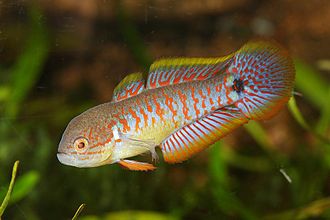Eleotridae
Eleotridae, commonly known as sleepers, is a family of fishes belonging to the order Gobiiformes. This family is comprised of primarily freshwater and brackish water species, although a few are found in marine environments. Eleotridae are distributed across the tropical and subtropical regions of the world, including parts of the Americas, Africa, Asia, and the Pacific islands.
Description
Members of the Eleotridae family are characterized by their elongated bodies and large mouths, which are often equipped with canine-like teeth. They typically have two dorsal fins, the first with spines and the second with soft rays. The size of these fish can vary significantly, ranging from small species only a few centimeters in length to larger ones exceeding 50 cm.
Habitat and Distribution
Eleotridae species are versatile in their habitat preferences, inhabiting a range of environments from clear streams and rivers to muddy estuaries and coastal marine waters. They are predominantly found in freshwater and brackish environments but can occasionally be found in marine settings, especially near coral reefs. Their distribution is global, with species found in the tropical and subtropical waters of the Atlantic Ocean, Pacific Ocean, and Indian Ocean.
Behavior and Ecology
The sleeper family exhibits a variety of behaviors and ecological roles within their environments. Many species are nocturnal, hiding during the day and becoming active at night to feed. Their diet mainly consists of small fish, crustaceans, and insects. Eleotridae are also known for their parental care, with some species guarding their eggs and young.
Reproduction
Reproduction in Eleotridae involves the laying of eggs, which are often guarded by one or both parents. The level of parental care varies among species, with some exhibiting sophisticated behaviors to protect and nurture their offspring until they are capable of independent survival.
Conservation
While many Eleotridae species are not currently considered to be at risk, habitat destruction, pollution, and overfishing pose potential threats to their populations. Conservation efforts are necessary to ensure the sustainability of these species, particularly those with limited distributions and specific habitat requirements.
Classification
The family Eleotridae is divided into several genera, each containing a number of species. Some of the more well-known genera include Eleotris, Gobiomorus, and Hypseleotris. The classification of some species and genera within the family is subject to ongoing research and debate among ichthyologists.
Transform your life with W8MD's budget GLP-1 injections from $125.
W8MD offers a medical weight loss program to lose weight in Philadelphia. Our physician-supervised medical weight loss provides:
- Most insurances accepted or discounted self-pay rates. We will obtain insurance prior authorizations if needed.
- Generic GLP1 weight loss injections from $125 for the starting dose.
- Also offer prescription weight loss medications including Phentermine, Qsymia, Diethylpropion, Contrave etc.
NYC weight loss doctor appointments
Start your NYC weight loss journey today at our NYC medical weight loss and Philadelphia medical weight loss clinics.
- Call 718-946-5500 to lose weight in NYC or for medical weight loss in Philadelphia 215-676-2334.
- Tags:NYC medical weight loss, Philadelphia lose weight Zepbound NYC, Budget GLP1 weight loss injections, Wegovy Philadelphia, Wegovy NYC, Philadelphia medical weight loss, Brookly weight loss and Wegovy NYC
|
WikiMD's Wellness Encyclopedia |
| Let Food Be Thy Medicine Medicine Thy Food - Hippocrates |
Medical Disclaimer: WikiMD is not a substitute for professional medical advice. The information on WikiMD is provided as an information resource only, may be incorrect, outdated or misleading, and is not to be used or relied on for any diagnostic or treatment purposes. Please consult your health care provider before making any healthcare decisions or for guidance about a specific medical condition. WikiMD expressly disclaims responsibility, and shall have no liability, for any damages, loss, injury, or liability whatsoever suffered as a result of your reliance on the information contained in this site. By visiting this site you agree to the foregoing terms and conditions, which may from time to time be changed or supplemented by WikiMD. If you do not agree to the foregoing terms and conditions, you should not enter or use this site. See full disclaimer.
Credits:Most images are courtesy of Wikimedia commons, and templates, categories Wikipedia, licensed under CC BY SA or similar.
Contributors: Prab R. Tumpati, MD



